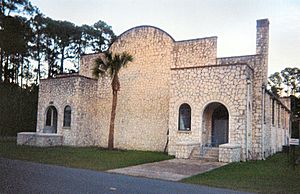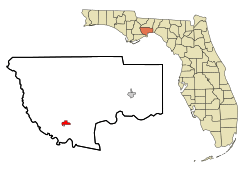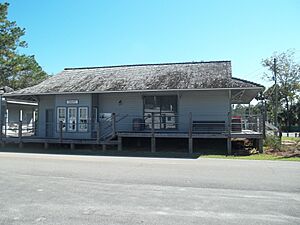Sopchoppy, Florida facts for kids
Quick facts for kids
Sopchoppy, Florida
|
|
|---|---|
| City of Sopchoppy | |

Old Sopchoppy High School Gymnasium
|
|

Location in Wakulla County and the state of Florida
|
|
| Country | |
| State | |
| County | Wakulla |
| Settled | 1894 |
| Incorporated | 1955 |
| Government | |
| • Type | Mayor-Council |
| Area | |
| • Total | 1.68 sq mi (4.35 km2) |
| • Land | 1.68 sq mi (4.35 km2) |
| • Water | 0.00 sq mi (0.00 km2) |
| Elevation | 30 ft (9 m) |
| Population
(2020)
|
|
| • Total | 426 |
| • Density | 253.87/sq mi (98.01/km2) |
| Time zone | UTC-5 (Eastern (EST)) |
| • Summer (DST) | UTC-4 (EDT) |
| ZIP code |
32358
|
| Area code(s) | 448/850 |
| FIPS code | 12-66925 |
| GNIS feature ID | 0306416 |
Sopchoppy is a city in Wakulla County, Florida, United States. The city is located on the Florida Panhandle in North Florida, with Ochlockonee River State Park located nearby. It is part of the Tallahassee, Florida Metropolitan Statistical Area. The population was 426 at the 2020 census, down from 457 at the 2010 census.
Contents
Geography
The City of Sopchoppy is located at 30°3′36″N 84°29′28″W / 30.06000°N 84.49111°W (30.059994, –84.491084).
According to the United States Census Bureau, the city has a total area of 1.5 square miles (3.9 km2), all land.
Climate
The climate in this area is characterized by hot, humid summers and generally mild winters. According to the Köppen climate classification, the City of Sopchoppy has a humid subtropical climate zone (Cfa).
History
The city's name is a corruption of "Lockchoppe", derived from the Muskogee lokchapi ("lokcha" meaning "acorn", and "api" meaning "stem"), which was the old name of the nearby river.
Mention of Sopchoppy can be found in 1850, in a runaway slave ad published by Henry Mash in the May 7, 1850 Florida Sentinel newspaper of Tallahassee. This is nearly 50 years earlier than the 1894 claim noted below.
Sopchoppy came into existence in 1894 after the CT&G Railroad Company built a railway through the area. It platted the city on property it already owned in the area, across the river from Greenough. To encourage people to settle the area, the railroad engaged in an advertising campaign, exaggerating the quality of the soil and climate.
The Sopchoppy Depot was built in 1891. Now a museum, it was built for the Carrabelle, Tallahassee & Georgia Railroad (G. F. & A.), and referred to colloquially as the "Gopher, Frog & Alligator, Company", which was absorbed by the Georgia, Florida and Alabama Railroad. The line began in 1893 and closed in 1946. It transported lumber, turpentine and related products, honey, farm produce, soldiers, fish and oysters packed in barrels in ice as well as sturgeon caviar from the Sopchoppy River, frog legs, and catfish.
Although it has existed as a settlement since at least 1894, the City of Sopchoppy was officially incorporated as a municipality in 1955.
Demographics
| Historical population | |||
|---|---|---|---|
| Census | Pop. | %± | |
| 1960 | 450 | — | |
| 1970 | 460 | 2.2% | |
| 1980 | 444 | −3.5% | |
| 1990 | 367 | −17.3% | |
| 2000 | 426 | 16.1% | |
| 2010 | 457 | 7.3% | |
| 2020 | 426 | −6.8% | |
| U.S. Decennial Census | |||
2010 and 2020 census
| Race | Pop 2010 | Pop 2020 | % 2010 | % 2020 |
|---|---|---|---|---|
| White (NH) | 318 | 314 | 69.58% | 73.71% |
| Black or African American (NH) | 113 | 76 | 24.73% | 17.84% |
| Native American or Alaska Native (NH) | 2 | 4 | 0.44% | 0.94% |
| Asian (NH) | 3 | 1 | 0.66% | 0.23% |
| Pacific Islander or Native Hawaiian (NH) | 0 | 0 | 0.00% | 0.00% |
| Some other race (NH) | 0 | 0 | 0.00% | 0.00% |
| Two or more races/Multiracial (NH) | 11 | 17 | 2.41% | 3.99% |
| Hispanic or Latino (any race) | 10 | 14 | 2.19% | 3.29% |
| Total | 457 | 426 |
As of the 2020 United States census, there were 426 people, 220 households, and 119 families residing in the city.
As of the 2010 United States census, there were 457 people, 165 households, and 110 families residing in the city.
Notable people
- B. K. Roberts, Florida Supreme Court Justice, was born in Sopchoppy
Festivals
The city is home to the annual American Worm Gruntin' Festival, a city celebration named in honor of a worm grunting—also known as worm charming—a method for driving worms to the surface of the earth. Worm charmers hammer wooden stakes into the ground, then rub them with metal slabs. The resulting vibrations cause worms to surface, whereupon they are typically gathered and used or sold for fishing bait.
Part of Tim Dorsey's 2017 novel Clownfish Blues is set in Sopchoppy and worm grunting is a plot element.
See also
 In Spanish: Sopchoppy para niños
In Spanish: Sopchoppy para niños


